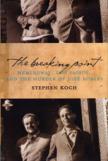To the Bitter End
The newest book from Stephen Koch, the celebrated author of Double Lives: Spies and Writers in the Secret Soviet War Against the West and The Modern Library Writer’s Workshop, is a riveting mix of biography and history. As biographer, Koch writes of Ernest Hemingway and John Dos Passos, their mercurial friendship in the 1920’s and 1930’s, and ultimately their estrangement in 1937. As narrative historian, Koch explores the Spanish Civil War and entanglements involving Spanish patriots, fascist agitators, international idealists and Soviet communists.
Koch begins The Breaking Point by introducing the main players. John Dos Passos, known as Dos to his friends, was a man whose devotion to friends and principles was motivated by his belief in the possibility of positive social and political change. In 1916, while visiting Spain, he met José Robles. Robles introduced the innocent American to the real Spain, where life was one vast ritual. The two remained steadfast friends throughout the remaining two decades of Robles’s life.
In 1918, Dos was again in Europe, but this time as an ambulance driver in war-torn Italy. There he met another ambulance driver, Ernest Hemingway, but little is known of that first encounter. The two met again in the early 1920’s in the American expatriate society of Paris. At that point, their friendship just took off. Back in America, throughout the 1920’s and early 1930’s, the two writers and their families frequently visited and vacationed with each other.
Not long after, however, the friendship began to deteriorate. Hemingway began showing signs of the emotional instability that would plague him his entire life. His egocentric insensitivity to friends was exacerbated by his almost total lack of social consciousness, his obsession with the horrors of war and his own self-destructive neuroses. Especially problematic were Hemingway’s marital infidelities and his abhorrence of anything that was not absolutely focused on his own interests.
Significant troubles began in 1935. Hemingway became more obsessive about his writing and even more self-centered in his relationships. Dos, who was busy with his own writing and therefore inattentive to Hemingway during one visit to Key West, was either incapable of understanding or unwilling to defer to his friend’s selfishness. Small incidents accumulated to an intolerable level, at least in Hemingway’s mind, and Hemingway began to lash out at his baffled friend. Hemingway’s annoyance found its poisonous way into To Have and Have Not, a substandard roman à clef in which Hemingway projected his hostility into the Dos-surrogate character, Richard Gordon.
The ultimate breaking point, however, came in 1937, during the Spanish Civil War. Hemingway and Dos were in Spain at the time, when José Roblesa patriot in the leftist Popular Frontdisappeared under mysterious circumstances. The Spanish Civil War was a crucible for many American artists who were drawn, like moths to flames, to international political involvement. Soviet Communists had deceived nearly an entire world into believing that support for the Popular Front (and Communism) was noble resistance to the threat of European fascism. Hemingway and Dos, in fact, were, at least for a time, completely drawn into Stalin’s deception. The two writers even became key players in producing the Stalinist propaganda film The Spanish Earth.
The Hemingway-Dos relationship finally reached its endgame, and volatile Hemingway, adroitly manipulated by Communist operatives eager to demoralize Dos Passos, whom they then viewed as irrelevant, committed a coup de grâce. On April 22, 1937, at a fiesta celebrating international brigade involvement in the war, Hemingwayas if on cue from Staliniststold Dos what he had heard about José Robles. As Koch puts it, Hemingway was glowing with confidence and cruelty, cutting into Dos Passos with the news’ that Robles had been shot as a proven fascist collaborator, a renegade, a dirty spy, a betrayer of his friends. Dos was devastated.
The remaining 100 pages of The Breaking Point examine the pathetic dénouement of the two writers’ relationship, the different qualities of each one’s works and the progress of their careers.
It is essential to remember that most of what was said about Robles on April 22, 1937, was a sadistic lie unaccountably perpetrated on Dos by a gullible Stalinist stooge named Hemingway. Yes, the patriotic Robles had been murdered, but at the hands of individuals never identified, under circumstances never documented. His murder remains an important mystery.
There are mysteries, likewise, in Koch’s text itself. He does not explain, for example, why Hemingway came to despise Dos (who would for the rest of his life mourn both the mysterious death of Robles and the loss of his friendship with Hemingway). Also, Koch does not explain how and why Hemingway was so easily manipulated by Stalinist political forces that were far beyond his understanding or interest. Finally, Koch does not explore the ways in which Dos may have either deliberately or unwittingly exacerbated the tensions that resulted in the 1937 crisis.
Despite these and other shortcomings, The Breaking Point is a well-documented and nicely annotated book that offers intriguing perspectives on two fascinating personalities. Koch’s insights alone make the book worthwhile. Additionally, he offers an important look at the ways politics and artistsfor better or worsebecame intertwined in the 1930’s. In the turmoil of 2005, that may be the book’s most important and relevant perspective.
This article also appeared in print, under the headline “To the Bitter End,” in the May 30, 2005, issue.








